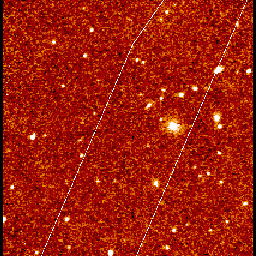
In the late 1960s, the United States launched an array of satellites into eccentric orbits around the earth to detect illegal nuclear testing, even from behind the moon. No nuclear detonations from the earth were ever seen, but many bizzare events were found to be coming from outside the satellite orbits. Short, intense flashes of high-energy radiation were occuring from all directions in the sky. Attempts to correlate these bursts with known astronomical processes, such as solar activity or supernovae, proved futile. A completely new phenomenon had been discovered.
Today, gamma-ray bursts (GRBs) remain one of the outstanding mysteries in astronomy. Less is known about GRBs than any other astronomical object or phenomenon, even though they occur several times a day and may represent the largest explosions in the universe. The cause of these events is completeley unknown: over one hundred different origin theories exist. The distance scale of GRBs is uncertain by 12 orders of magnitude: they could be coming from the edge of our solar system or the edge of the universe. The total burst energy is uncertain by 24 orders of magnitude.
GRBs appear to be distributed isotropically in the sky, and there is a relative paucity of fainter bursts compared to brighter ones. This suggests that we are at the center of a spherically symmetric and bounded population of bursters. Only one other class of astronomical objects shares this distribution: distant cosmological objects such as galaxies. In fact, nearly all cosmological GRB models require the presence of a galaxy to contain the bursting object. Perhaps the most damaging evidence against the cosmological interpretation is the "no-host" problem: the lack of galaxies at many GRB positions. However, the imaging programs on which this conclusion was based were neither deep enough nor consistent enough to make a definitive statement about the presence of suitable host galaxies.
Larson's dissertation research consists of the design, execution, analysis and interpretation of a deep near-infrared imaging survey of the most precise GRB localizations to probe the cosmological content of these regions to a significant depth. The program has been designed to test the reality of the no-host problem and to search for any objects whose presence is unusual by random chance.
Searching for quiescent counterparts to GRBs requires accurate burst localizations. These are obtained by triangulation using time-arrival measurements from a network of widely separated burst-sensitive spacecraft, which result in positional error boxes several arcminutes in size. Our targets consist of only the smallest error boxes from the latest network, for the highest statistical significance and a consistent sample of events.
Near-infrared is the optimal wavelength regime in which to search for extragalactic sources. The good spatial resolution and large field of view needed for this imaging survey are only possible at visible and near-infrared wavelengths. Galaxies are brightest in the near-infrared, and infrared light is much less inhibited by interstellar dust, which absorbs visible light. Near-infrared wavelengths, combined with a large telescope and long exposure times, allow us to reach levels that assure detection of a reasonable host galaxy.
